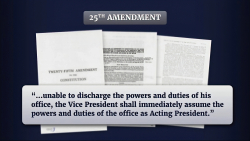
Though opposition to President Trump’s tariffs comes from many quarters, most critics focus on their cost to American consumers. A jump in consumer prices in June prompted such commentary in the Wall Street Journal and elsewhere. The tariffs, the Journal noted, had begun to “seep into prices.”
A look at the details of the Labor Department’s report, however, casts considerable doubt on those assertions. And while tariffs may impose some cost on households, the extent of that burden is far from clear.
Finally, a reason to check your email.
Sign up for our free newsletter today.
Preliminary reports show consumer prices accelerating in June. According to the Labor Department, June saw a 0.3 percent increase over May’s price levels—2.7 percent at an annual rate. This figure was higher than the 1.8 percent annual rate of advance in the two prior months, and higher than the 2.0 percent that the Federal Reserve targets as acceptable. But it fell easily within the usual variations in month-to-month statistics.
For all the concern surrounding the recent acceleration in consumer inflation, none of it points clearly to a tariff effect. The sharpest June price increases were in goods largely produced domestically, where tariffs don’t apply. Fruit and vegetable prices, for example, rose 11.4 percent year-over-year. While the U.S. does import some of these items—especially in winter—imports still don’t dominate the market.
Nonalcoholic beverages saw an even bigger jump, rising at an annual rate of 18.2 percent—again, with little relevance to tariffs, given the dominance of domestic production. Other leading contributors to June’s price surge were also largely domestic: hospital services rose 8.7 percent, while energy—especially fuel oil and electricity—climbed nearly 11.5 percent.
Meantime, product categories with significant import shares—where tariffs would most likely “seep into prices”—saw relatively modest price increases, if that. Auto prices, for example, fell at a 3.5 percent annual rate. Apparel rose about 5 percent, only slightly above the overall rate. And alcoholic beverages, which rely heavily on imports, saw just a 1.2 percent annual increase.
A separate Labor Department report on import prices supports this picture. Overall, import prices in June rose at just over a 1.0 percent annual rate. Some goods, such as metals, saw a more significant increase—up 1.2 percent for the month, or 15.4 percent annually—which may reflect tariff effects. But other major import categories, including capital goods like machinery and transportation equipment, showed no inflation at all.
If tariffs are to impose a burden, it likely hadn’t materialized in June, though it may do so in the months ahead. Even then, the impact is likely to be more limited and nuanced than many critics claim.
The standard analysis of tariffs typically adds the tariff rate to import prices, estimates the share of imports in the U.S. economy, and uses these figures to calculate the inflationary impact. While plausible, this approach reflects more of a worst-case scenario than a likely outcome.
It assumes Americans will keep buying the same imported goods at higher, post-tariff prices. But many households will probably shift to domestic alternatives. These may be more expensive than pre-tariff imports, but still cheaper than imports with tariffs. As a result, the cost of living would rise, but by less than standard estimates suggest, since imports would make up a smaller share of overall consumption.
Consumers might go even further—in the presence of higher import prices, they could change the sorts of things they buy completely. In this case, the impact on the cost of living could even be nil, though the loss of choice and preference implies a lower quality of life. In any case, the inflationary effect would certainly be less than predicted in the standard analysis.
There’s also a strong chance that foreign producers and U.S. importers will absorb part of the tariff costs in their profit margins to keep prices competitive. The large markups on some imports make this not only possible but likely—several Chinese exporters have already signaled plans to do just that.
If producers and importers absorb part of the tariff costs, the inflationary impact will be reduced. Currency movements could soften the effect further: if tariffs cause foreign currencies to depreciate against the dollar, the dollar price of imports would decline, offsetting some or even all of the added tariff expense.
That’s exactly what happened in 2019, when Trump first imposed tariffs on Chinese imports. The yuan depreciated enough to offset the tariffs, leaving dollar prices largely unchanged and U.S. sales steady. Chinese exporters took the hit, earning fewer dollars per sale.
The coming months will clarify the real impact of new tariffs on prices and living costs. The effect may be noticeable, but almost certainly less severe than current worst-case projections suggest. A better grasp of these dynamics would serve both the media and the public.
Photo by Liao Pan/China News Service/VCG via Getty Images
City Journal is a publication of the Manhattan Institute for Policy Research (MI), a leading free-market think tank. Are you interested in supporting the magazine? As a 501(c)(3) nonprofit, donations in support of MI and City Journal are fully tax-deductible as provided by law (EIN #13-2912529).
Source link

















